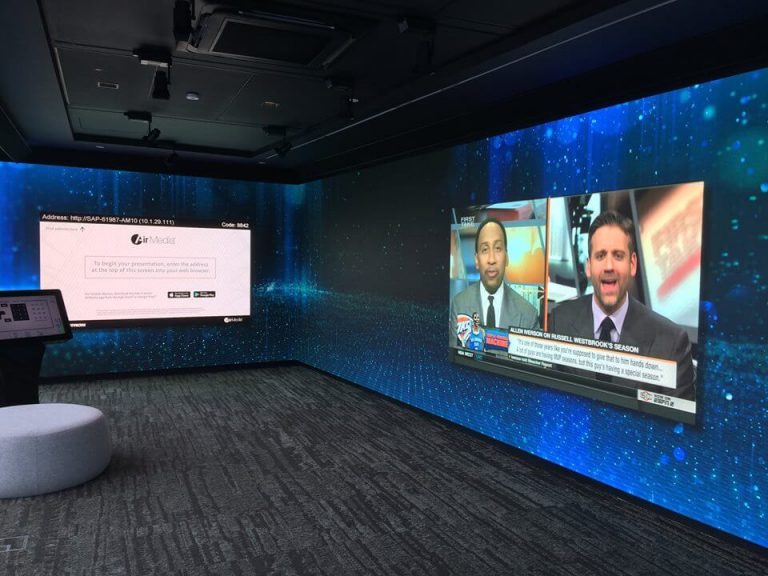5 Digital Signage Trends to Watch in 2018
We’re in the midst of an explosion. The global market for digital signage is now worth an estimated $16 million and by 2025 it’s projected to reach $31 million.1 Previously, the industry was focused on enhancing the hardware—primarily increasing the size and resolution of displays. But, now it’s following these five trends—with a strong emphasis on improving the customer experience.
#1 An Explosion in the Size and Number of Video Walls
Large displays are stunning. IVCi just completed one in the modern, new global headquarters for a world-renowned New York City-based client. Just walk into their lobby and you’ll immediately be “wowed” by its massive 22.1 x 39.4 ft. seamless video wall. Whenever there’s a need to make an impact on an audience, nothing does it better. That’s why this leader in fashion partnered with IVCi to create a massive, bezel-free wall, and more are appearing in retail, corporate, banking, healthcare, education, and transportation.2 Video walls are increasing in numbers and used in many types of configurations, including non-rectangular displays and ultra-thin bezels. It’s expected that this trend will continue to significantly increase.
#2 Personalized, Interactive Displays
From restaurants to retail and beyond, interactive displays now allow customers to participate. The goal is to provide technology built around people to improve communication and strengthen engagement. Similar to the objectives of social media marketing, digital signage is meant to relate to a person as an individual with the intent of building a community of followers, not just selling a product. By using interactive displays with personalized communication, the customer will have better access to what they desire.
#3 Responsive Content
When compared to traditional print media, digital signage is easy-to-use and flexible. Messaging is created using a content management system (CMS) and can be tailored to a specific situation. For example, a business can display the logo of a visiting client. But, using a CMS still requires the “pot to be watched.” However, now there are web-based services that allow content to be changed based on a specific situation. For example, a retail store can set a trigger based on the weather. If it’s raining, the content management system will automatically change to present a predefined “rain” playlist.3 Also, motion detectors that sense when someone enters a room can be used to start a presentation. Making content current and meaningful is another way digital signage is moving towards improving the customer experience.
#4 OLED for Brand Building and Engagement
OLED (Organic Light Emitting Diodes) is a flat, light-emitting technology made by placing a series of organic thin films between two conductors. When electrical current is applied, a bright light is emitted, so OLEDs don’t require a backlight and are thinner and more efficient than LCD displays.4 Since they’re ultra-slim, flexible and almost weightless, they can be rolled up like a newspaper, installed over glass like a tint, and viewed from both sides. In fact, it’s the perfect technology for digital signage on a store front; the messaging can be read while also viewing the inside of the store. A 65” prototype is now available that’s “rollable,” when last year only an 18” was available, so this technology is really thriving. This flexible, lightweight display provides an immersive experience on modern architecture; it can fit the contours of a design and emphasize curves, something previously not possible with rigid rectangular displays.5
#5 Options for All
Digital signage is no longer just an option for large, affluent corporations. Previously a one-size-fits-all approach, the industry has morphed to include many simple to use, affordable options that appeal to even small businesses.
“It was inevitable and obvious that any display with an onboard PC, or even a simple NUC attached to the back of a display and connected to the network, could be signage ready. In addition, cloud collaboration platforms such as Google G SUITE or ZOOM that have web-based, device management capabilities, can easily deploy and manage applications like signage on unlimited devices. Whether it is a Chromebox for Digital Signage or a Zoom Room presenting digital content, these devices are easily monitored and managed so you can send content to any devices.”
Want to learn more about digital signage? Need help with managing your content? IVCi, an AV expert with over two decades of experience, can work with you to design the perfect solution for your needs. For more information, visit www.ivci.com or contact your local IVCi sales representative at 800-224-7083.
1,2 Digital Signage Market Analysis By Type, By Component, By Technology, By Application, By Location, By Content Category, By Size, By Region, And Segment Forecasts, 2014 – 2025, Market Research Report, Sept. 2017
3 What the Future Holds for Digital Signage, Viewneo, Oct. 2017
4, 5 OLED for Brand Building and Engagement, Digital Signage Today, July 2016


